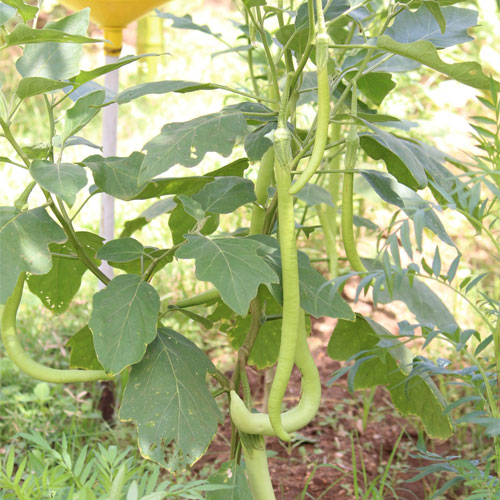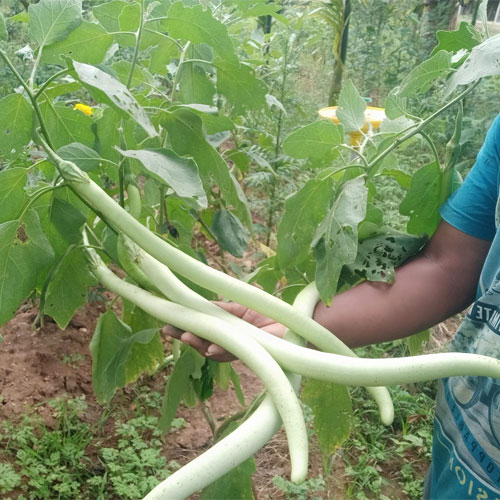Total Number of seeds: 50
🌱 Illikomban Brinjal Seeds are a rare heirloom treasure from the southern parts of Kerala and Tamil Nadu. Known locally as "Illikomban" or “Green Snake Vengeri Brinjal,” this variety is loved for its extra-long, slender fruits, which grow up to 1.5 to 2 feet in length. With meaty flesh, minimal seeds, and superior taste, this variety is ideal for organic and natural farming.
If you're looking to revive indigenous vegetable varieties or grow organic brinjals without chemicals, Illikomban is the perfect choice. This variety thrives in tropical climates, offers high yields, and has been passed down for generations in homesteads of Kerala and Tamil Nadu.
Variety Name: Illikomban (Green Snake Vengeri Brinjal)
Type of Seed: Open Pollinated, Native Heirloom Variety
Germination Time: 7–14 days
Sunlight Requirements: 6–8 hours of full sunlight daily
Growing Locations: Backyard gardens, farms, terrace pots with support
Growing Season: June to December (best sown just before or during monsoon)
Seed Sowing Depth: 0.5 to 1 cm
Ideal Climate: Warm and humid; tropical to subtropical regions
Plant Height: 3–5 feet (requires staking or support)
Fertilizer Needs: Rich organic compost; neem cake and jeevamrut recommended
Life Span: Seasonal (8–10 months fruiting cycle)
Ideal Growing Temperature: 22–32°C
Harvesting Time: 70–90 days after sowing
Maintenance Required: Moderate
Watering Frequency: Alternate day watering; reduce during rains
Ideal Grow Bag Size: Minimum 18-inch depth and width


What Size Grow Bag is Best for Illikomban Brinjal Seeds
The best time to sow Illikomban brinjal seeds is from June to September or during the post-monsoon months of October–November. These months offer optimal soil moisture and warmth for vigorous root development and flowering.
Choose a large grow bag or earthen pot (at least 18-inch depth)
Fill with well-drained soil mixed with compost
Sow 2–3 seeds and thin to the healthiest plant after germination
Place in full sun and water moderately
Support the growing plant with sticks or trellis as it starts to vine
Preparation: Soak seeds in water for 6 hours before sowing
Sowing: Direct or in trays; transplant when 6–8 inches tall
Watering: Light watering till germination, avoid water stagnation
Germination Time: 7–14 days
Transplanting: After 20–25 days
Sunlight: Ensure full sun, avoid shade
Soil: Loose, well-draining, compost-rich soil
Fertilization: Use panchagavya or compost tea every 2 weeks
Pruning: Remove side shoots to promote stronger fruits
Support and Spacing: 2 ft spacing; provide bamboo or trellis support
Pest Control: Spray diluted neem oil for mealybugs or whiteflies
Disease Prevention: Rotate crops; avoid overwatering
Mulching: Maintain soil moisture and reduce weeds
1. Apply Nutrient-Rich Fertilizers
When your plants begin flowering, use nutrient-rich fertilizers like Organic Bone Meal Powder or Vermicompost. This helps in boosting the bloom and enhances overall yield.
2. Use Organic Fertilizers
Feed your plants with organic fertilizers such as Cow Dung Manure or Neem Cake. Organic options promote healthy soil life.
3. Regular Feeding
Apply fertilizers every 20-25 days to ensure plants receive a steady supply of nutrients. Choose from various options like Cocopeat Compost for moisture retention.
🌿 Heirloom Variety: Saved by generations of farmers in South India
🍆 Long Slender Fruits: Up to 1.5 to 2 feet, bright green, soft flesh
💚 Low Seeds, High Taste: Excellent for curries, fries, and traditional recipes
🚜 Ideal for Organic Farming: Strong pest tolerance and low input cost
🧺 High Yielding: 2–3 kg per plant in peak season
♻️ Revival of Traditional Genetics: Excellent choice for seed savers
Best for Indian cuisine – makes flavorful sambar, fry, bharta, and chutneys
Traditional medicine – consumed for digestion and iron content
Cultural relevance – widely used in temple cuisine and Ayurvedic diets
Homegrown taste – fresher and tastier than market brinjal
Excellent for Permaculture – adapts well with other vegetable companions
Avoid using chemical fertilizers or pesticides
Ensure staking support as fruits are long and may droop
Harvest early to avoid bitterness in overripe fruits
Protect from fruit borer with neem spray or marigold as trap crop nearby
Wilting: Ensure well-drained soil; avoid root rot
Aphids/Whiteflies: Spray neem oil + garlic extract
No Fruit Set: Use manual pollination in dense areas
Yellowing Leaves: Add compost or panchagavya spray every 15 days
Fruit Borer: Use pheromone traps or neem oil foliar spray
Sign in now to receive a 5% instant discount on your first order when using code WELCOME. Begin your organic journey today!
By logging in, you're agreeing to our Terms of Service and Privacy Policy.
Harish
Curved brinjal dekh kar sab family members surprised ho gaye!
Suresh
Illikomban brinjal ka shape bilkul unique hai, snake jaisa curved hota hai.
Kiran
Light green color aur texture kaafi different tha market brinjals se.
Anand
Iska taste bahut soft aur mildly sweet tha — fry ke liye best.
Deepa
Kerala ka traditional variety hai, taste bhi ekdum authentic laga.
Manoj
Bahut productive plant nikla — har plant se 15–20 brinjals aaye.
Vikram
Seedlings strong nikle, transplant bhi easy ho gaya.
Venu
Bahut acha laga Kerala ka heirloom seed milna online.
Reena
First time grow kiya tha, aur result beyond expectation mila.
Lalitha
Germination achhi hui — almost 90% seeds sprouted within a week.